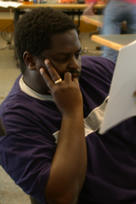Summer School Diaries
Diary of the 2003 Summer School on Theoretical and Computational Biophysics
Tuesday, June 10 -- Kirk Williams
 It was a capstone of a beautiful two weeks. Officially it was an
unofficial social gathering of 11 scientist to discuss our daily
journals. Our journals would cover events over the course of two
weeks. Rosemary, a senior graduate student in Dr. Schulten's
group, explained to us how the summer school came about, how it
worked, who are the major planners, and what was going on during each
of the daily tutorials. It was made straight forward and simple, tell
us some information about that you think the program did for you.
With my objective in hand, my mission was clear: write, express,
discuss, and report our thoughts of the day's activities.
It was a capstone of a beautiful two weeks. Officially it was an
unofficial social gathering of 11 scientist to discuss our daily
journals. Our journals would cover events over the course of two
weeks. Rosemary, a senior graduate student in Dr. Schulten's
group, explained to us how the summer school came about, how it
worked, who are the major planners, and what was going on during each
of the daily tutorials. It was made straight forward and simple, tell
us some information about that you think the program did for you.
With my objective in hand, my mission was clear: write, express,
discuss, and report our thoughts of the day's activities.
"I was able to complete
the tutorial, understand my results, and begin to ask questions of my
own research based on what was taught thus far."
Today's lecture, from Dr. Zan Schulten, focused on Bioinformatics of Proteins: Protein Structure Prediction and Function, Sequence and Structure Alignment Algorithms, and Sequence-Structure Analysis Tools on the Web. I had a Bioinformatics class, but evidently some of the things discussed there did not cover the topics that Zan focused on here. The lecture was great. I was able to fill in the gaps in my knowledge that I did not know existed and I was about to learn more about the Blosum Substitution Matrix, Structural Alignments and Hidden Markov Models (HMM). The daily question and answer period gave me a clearer understanding of the Smith-Waterman sequence-sequence alignment. I still can not see the difference between it and Needleman-Wunsch's matrix, but maybe I will catch the difference sometime soon. Although I heard of the topics before, it was unclear how Tracebacks worked and how Gap Penalties actually hurt your scoring and alignments. Overall, today's lectures were very informative, and it cleared up some misconceptions in my knowledge.
The afternoon hands-on session was excellent. I was able to complete the tutorial, understand my results, and begin to ask questions of my own research based on what was taught thus far. From talking with others, they, like myself, have seen ways to incorporate and adapt VMD and NAMD to their research projects.
< Previous | Index | Next >



